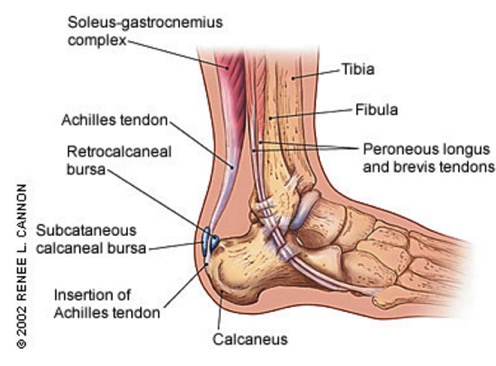Running is as much a mental sport as it is physical. As an endurance activity, you must both manage physical pain and exercise mental fortitude in order to overcome limits. At times the mental strength that you display can heighten your risk for possible injury, especially when it is used as a tool for conquering pain. Gaining an understanding of how you can limit the effects of tremendous forces placed on your heel during this exercise can help you reduce their effects on your body while helping you bypass obstacles and reach new boundaries.
Basics of Your Feet
Your feet are vital to the process of the locomotion of your body. They are comprised of 26 bones alongside 33 joints. There are also over one hundred tendons, muscles, and ligaments that play a role in the function of your foot. Your feet are responsible for allowing locomotion while bearing and transmitting body weight while you run, walk, and stand upright.
Your heel is a major point of attachment for both the arches of your feet as well as your Achilles tendon. It is the largest bone in your foot and deals with a significant amount of force both from the actuation of body parts which surround it and as a result of the vertical forces placed on it during locomotion. The stress placed on your foot while walking can be 1.25 times your body weight, and up to 2.75 times while you are running. This makes your heel susceptible to pain and even damage.
How Does Your Achilles Tendon Work?
Your Achilles tendon, also referred to as the calcaneal tendon, is the thickest in your body. It attaches several muscles, gastrocnemius, plantaris, and soleus, to your heel bone or the calcaneus. Flexion is achieved at the ankle and knee by way of this tendon and its attachment to your muscles. This tendon is useful as it functions in assisting you with standing on the balls of your feet, walking, jumping, and running.
How Do the Arches of Your Feet Work?
The arches of your feet are especially important as their structure assists with reducing the cost of energy-related to walking, jogging, and/or running. Your arches include a very important ligament, the plantar fascia, which is responsible for connecting your heel to your toes.
The elastic properties of this ligament are the driving force in lowering the energy required for each step. As you take a step, the arches in your feet expand to properly support your body weight. Once you start to shift your body weight off of your foot and onto the other, the arches contract, which provides you with a spring in your step.
Causes of Heel Pain
Heel pain can have some pretty common causes, which include:
Heel bursitis – This is the inflammation of the rear of your heel, specifically the retrocalcaneal bursa, a sac of synovial fluid which is acting as a lubricant and cushion where your Achilles tendon slides over the heel bone.
Chronic inflammation of your heel pad – This can be caused by heavy footsteps and/or a wearing of the heel pad resulting in its thinning.
Stress fracture – This can be caused by osteoporosis or repetitive stress to the heel bone.
Achilles tendonitis – This is caused by irritation and inflammation which can cause pain, but constant inflammation can be a factor in the degeneration of this tendon. The progressive degradation of this tendon is often the cause of diagnosing tendonitis here.
Plantar fasciitis – This is caused by the irritation and inflammation of your plantar fascia. Inflammation is normally a result of the overstretching of this ligament, and most usually pain arises at, or near the heel bone or middle of the foot.
What Can You Do?
There are some simple steps that you can take to reduce the forces at work which cause heel pain and increase your chances of avoiding injury.
Take the time to properly warm up and stretch before running. Ensuring that your muscles, tendons, and ligaments are warm and limber should help increase flexibility and decrease the chances of pain, sprain, strain, and/or tears due to unnecessary tension or stiffness.
Heel pain orthotics such as insoles can also play a significant role in reducing the impact of running, walking, or jogging on your musculoskeletal system. They provide the necessary support and stabilization as well as promoting appropriate alignment to increase your performance and reduce the wear and tear on your body. They are also useful for helping to relieve pain associated with imbalances and plantar fasciitis, as well as high arches.
Lastly, you should always be conscious not to overexert yourself. Not only can this be a direct cause of injury, but can present with plenty of warning signs in the form of pain. Paying attention to pain and recognizing its role in alerting you to damage to your body is an effective mental tool.
















